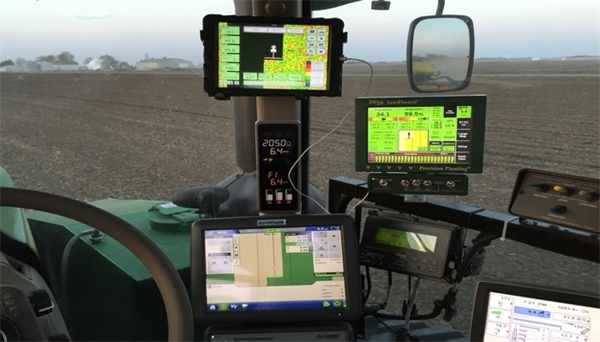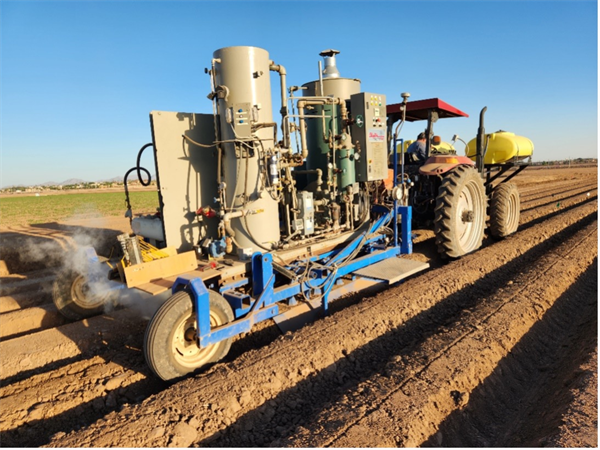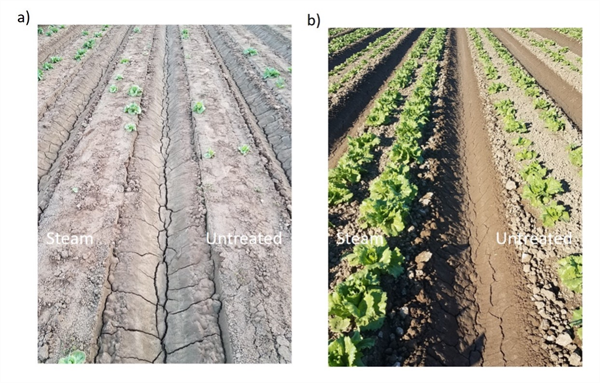
The continuous development, testing, and incorporation of technology in agriculture is amazing. I recently attended a western agricultural conference and when visiting the industry displays and booths, I was impressed with the new technologies that are coming into the agricultural arena.
Technological devices are tools and like all other tools, they are put to their best use in the hands of skilled craftsmen.
We have many excellent examples of technological tools in the crop production systems of the desert Southwest. A basic example comes from the equipment used to till the fields, prepare a good seedbed, and then to plant a new crop by seed or transplant. Excellent articles are provided in this newsletter on this topic regularly. We tend to take this kind of equipment for granted until you must do the job by hand or with older technology.
Any new technology needs to be fully tested and demonstrated before anyone can expect it to be appropriately implemented. That involves communicating the background, purpose, and utility of any new technology. The cost/benefit ratios need to be worked out and presented. A critical step in implementation is demonstration and establishing prima facie evidence to support the value of the new technology. Testimonials are nice but there needs to be solid evidence to support claims of merit. In science ideas demand testing and the presentation of proof.
A lot of emphasis recently has been placed on the technology and new tools available for soil-plant-water management and irrigation management. There is a tendency for some people to think that our problems can all be solved with crop water management if we would just use the right technology. In my view, some of the new irrigation technology is great and it can potentially be very useful in managing crop irrigation in the field. But technology itself is not a panacea.
Despite the technological advancements that we do use and benefit from, the best potential improvements are dependent upon the skill and expertise of the farmers or field managers involved. The skill set required to plant a crop, get a good stand, manage it to the proper level of maturity, harvest the crop, and then get it to market is indispensable and the responsibility comes down to individual farmers and farmer managers.
The successful management of irrigation technology is totally dependent on the skill of the operator to make a personal assessment of a broad array of factors. These factors include a review and assessment of the field in terms of crop condition and stage of growth, the soil moisture levels in relation to field capacity of the soil, the crop-specific irrigation requirements, allocating the appropriate amount of irrigation water needed, and the optimum time of application.
The ability of the farmer and/or farm manager to evaluate soils in the field regarding texture, water holding capacity, and current soil-water levels is essential. Simple methods such as using a soil probe and estimating soil-water levels by feel with their hands remains and will continue to be a critical skill for farmers and field managers.
I believe this is particularly true if one is trying to employ new technologies for irrigation management. A good farmer can tell if the tools and technologies being employed are working properly. They are the ones that usually take new tools to levels of use above and beyond what the developers were able to envision.
We all need a baseline in relation to crop-water management and the fundamentals will continue to be an important part of a farm manager’s skill set. The new technologies may serve as good tools, but they will not replace the capacity of a farm manager to go into the field and figure out what is going on, put the tools or technologies to work appropriately, and not only apply them but do it well.
Fundamentals are important, and they always will be. This illustrates the fact that skilled professionals are essential in crop production.

Hi, I’m Chris, and I’m thrilled to be stepping into the role of extension associate for plant pathology through The University of Arizona Cooperative Extension in Yuma County. I recently earned my Ph.D. in plant pathology from Purdue University in Indiana where my research focused on soybean seedling disease caused by Fusarium and Pythium. There, I discovered and characterized some of the first genetic resources available for improving innate host resistance and genetic control to two major pathogens causing this disease in soybean across the Midwest.
I was originally born and raised in Phoenix, so coming back to Arizona and getting the chance to apply my education while helping the community I was shaped by is a dream come true. I have a passion for plant disease research, especially when it comes to exploring how plant-pathogen interactions and genetics can be used to develop practical, empirically based disease control strategies. Let’s face it, fungicide resistance continues to emerge, yesterday’s resistant varieties grow more vulnerable every season, and the battle against plant pathogens in our fields is ongoing. But I firmly believe that when the enemy evolves, so can we.
To that end I am proud to be establishing my research program in Yuma where I will remain dedicated to improving the agricultural community’s disease management options and tackling crop health challenges. I am based out of the Yuma Agricultural Center and will continue to run the plant health diagnostic clinic located there.
Please drop off or send disease samples for diagnosis to:
Yuma Plant Health Clinic
6425 W 8th Street
Yuma, AZ 85364
If you are shipping samples, please remember to include the USDA APHIS permit for moving plant samples.
You can contact me at:
Email: cdetranaltes@arizona.edu
Cell: 602-689-7328
Office: 928-782-5879
Last week, we initiated our first trial of the season examining the use of band steam for controlling Fusarium wilt of lettuce. The premise behind this research is to use steam heat to raise soil temperatures to levels sufficient to kill soilborne pathogens. For Fusarium oxysporum f. sp. lactucae (FOL) the pathogen which causes Fusarium wilt of lettuce, the required temperature for control is generally taken to be > 140°F for 20 minutes. Soil solarization, where clear plastic is placed over the crop bed during the summer, exploits this concept. The technique raises soil surface temperatures to 150-155˚F, effectively killing the pathogen and reducing FOL disease incidence by 45-98% (Matheron and Porchas, 2010).
In our trials, we are using steam heat to raise soil temperatures. Steam is delivered by a 35 BHP steam generator mounted on a custom designed elongated bed shaper (Fig. 1). As the device travels through the field, steam is injected into the soil in narrow bands centered on the seedline. Soil temperatures are raised to about 190°F. After cooling (< ½ a day), the crop is planted into the disinfested soil.
Trials conducted in prior years show the technique holds promise; however further work is needed. In these studies, a 4” wide by 2” deep band of soil was treated. Although soil assay results showed that steam treatment significantly reduced the number of Fusarium colony forming units by over 95% as compared to the untreated control, this didn’t always translate into reductions in disease incidence. At one field site with a known history of FOL, band-steam provided no benefit with virtually all lettuce plants succumbing to the disease (Fig 2a). However, at another site, disease incidence was reduced by more than 40%, plants appeared to be healthier and more vigorous, and yield was increased by more than 90% (Fig. 2b). One explanation for this difference is that at the first site, Fusarium inoculum loads were very high and the width and/or depth of soil treated by steam wasn’t large enough to protect seedling roots, which are highly susceptible to FOL, from infection. The aim of this year’s trial is to determine the width and depth of soil that needs to be disinfested to prevent disease. In the current study, we are examining bands of soil receiving steam treatment that range in size from 4” wide by 2” deep to 6” wide by 4” deep.
Stay tuned for final trial results and reports of our other studies examining the efficacy of using steam heat to control sclerotinia lettuce drop, pythium and weeds.
As always, if you are interested in trying band-steam on your farm or would like more information, please feel free to contact me.
References
Matheron, M. E., & Porchas, M. 2010. Evaluation of soil solarization and flooding as management tools for Fusarium wilt of lettuce. Plant Dis. 94:1323-1328.
Acknowledgements
This project is sponsored by USDA-NIFA, the Arizona Specialty Crop Block Grant Program and the Arizona Iceberg Lettuce Research Council. We greatly appreciate their support.
A special thank you is extended to Fatima Corona, Roberto Delgado, Chad VanMatre, Matt McGuire and JV Farms for their generous assistance and allowing us to conduct this research on their farm.

Fig. 1. Band-steam applicator principally comprising a 35 BHP steam generator
mounted on a bed-shaper applicator sled. The device injects steam into the soil
as beds are formed.

Fig. 2. Lettuce seedlings at field sites with (a) very high and (b)
moderate levels of Fusarium wilt of lettuce inoculum. Band-steam
(left) and untreated (right) plots are shown.
Teff grass (Eragrostis tef) is originally from Ethiopia and has gained a lot of interest in Arizona. This crop is planted between vegetables and grows under different conditions and soil types. It is a fast-growing crop and can be harvested multiple times. According to the Teff Grass Crop Overview and Forage Production Guide from 2007-09 in California it was cut an average of 4 times yielding 6.89 tons/acre. The palatability to livestock is good and some report that its preferred over other traditional grass hays1.
There is also a need for good weed control in Teff grass to satisfy buyers.
One herbicide that was tested for postemergence broadleaf weed control and crop safety is Simplicity (pyroxulam). A 24(c) Special Local Need Registration was extended for this product. Also, another product that is successfully used in our area for broadleaf weed control is Clarity (dicamba).
Teff is grown during the summer between other crops that could be susceptible to residue of herbicides, and it is important that any herbicide that is used doesn’t have long-term soil activity.
We conducted a trial last summer in the Yuma Valley to evaluate the crop safety of pyroxulam, dicamba and other herbicides. Our results for pyroxulam were consistent with the injury observed in the visual ratings obtained by B.J. Hinds-Cook, D.W. Curtis, A.G. Hulting and C.A. Mallory-Smith with a 10% recorded2.
Also, efficacy for the control Purslane (Portulaca oleracea) was evaluated. The following chart shows data obtained.
This time of year, John would often highlight Lepidopteran pests in the field and remind us of the importance of rotating insecticide modes of action. With worm pressure present in local crops, it’s a good time to revisit resistance management practices and ensure we’re protecting the effectiveness of these tools for seasons to come. For detailed guidelines, see Insecticide Resistance Management for Beet Armyworm, Cabbage Looper, and Diamondback Moth in Desert Produce Crops .
VegIPM Update Vol. 16, Num. 20
Oct. 1, 2025
Results of pheromone and sticky trap catches below!!
Corn earworm: CEW moth counts declined across all traps from last collection; average for this time of year.
Beet armyworm: BAW moth increased over the last two weeks; below average for this early produce season.
Cabbage looper: Cabbage looper counts increased in the last two collections; below average for mid-late September.
Diamondback moth: a few DBM moths were caught in the traps; consistent with previous years.
Whitefly: Adult movement decreased in most locations over the last two weeks, about average for this time of year.
Thrips: Thrips adult activity increased over the last two collections, typical for late September.
Aphids: Aphid movement absent so far; anticipate activity to pick up when winds begin blowing from N-NW.
Leafminers: Adult activity increased over the last two weeks, about average for this time of year.







